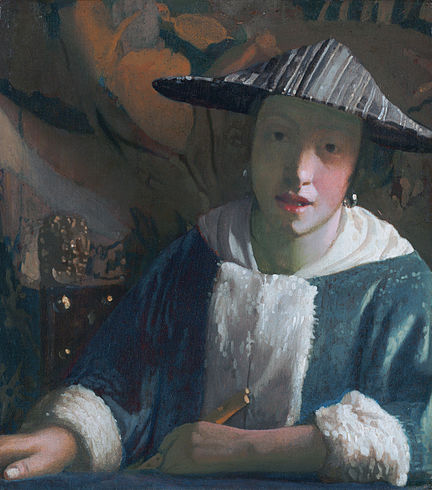"Ultramarine blue was also found in the gray mixture of the background. It is well known that Vermeer preferred this expensive blue pigment over cheaper options available in his time, and the inconspicuous use of ultramarine in the background is something one would typically see in a Vermeer painting. Because there are no surviving documents written by Vermeer, and no proof that he ever had any pupils to pass on his artistic methods, little is known of how the artist worked. However, his paintings are very distinct and tell us a lot about his modus operandi.
"It has often been thought that Vermeer used a camera obscura in order to create an accurate representation of three-dimensionality. Physical evidence has shown that he most likely used the pin-hole method as well. An X-ray of the painting in question made it possible to see this same pin hole that exists in many other Vermeer paintings."
Johannes Vermeer (probably 1665-1670), Girl With a Flute. Oil on Canvas, National Gallery of Art, Washington, DC. In 1942 the painting was given by Joseph Early Widener, Lynnewood Hall, Elkins Park, Pennsylvania. Note that the museum remarks that the painting " is only cautiously attributed to Johannes Vermeer. The general character, appearance, and some of the techniques of this work relate closely to Vermeer’s other works, especially to the Girl with the Red Hat. The quality of execution, however, does not match the master’s standards, probably because the image was extensively revised in the seventeenth century. "
"More than enough evidence was uncovered to prove that this painting is indeed a true work by Vermeer. However, questions still remain as to whether or not the retouching was done by the same hand. There are visible pentimenti— alterations to the painting — and X-ray and infra-red technology provide a look at a different composition underneath, with the figure wearing a jacket instead of a shawl. These alterations were made not too long after the first composition was completed. Arthur Wheelock, a Vermeer expert, believes this work was sold along with Girl with a Flute (c.1665–1670) shortly after the artist’s death, and then touched up to make the work appear more expensive."
Quoted paragraphs above are from ArtNet, Johannes Vermeer: The 36th Painting by Erica Trapasso on August 19, 2013
Editor's Note: For further reading, consult the paper Canvas Matches in Vermeer: A Case Study in the Computer Analysis of Fabric Supports by Walter Liedtke, C. Richard Johnson, Jr. and Don H. Johnson.
Don't forget to stop in at the online museum shop, a marvelous collection of gifts and exhibition products.
Pages: 1 · 2
More Articles
- Ferida Wolff's Backyard: Turtles Sunbathing
- Monetary Policy Report Prepared at the Federal Reserve Bank of Richmond, Expectations for Future Growth Were Mostly Unchanged
- Julia Sneden Wrote: Love Your Library
- Rebecca Louise Law: Awakening on View at Honolulu Museum of Art
- The Beige Book Summary of Commentary on Current Economic Conditions By Federal Reserve District Wednesday November 30, 2022
- A la Frank Sinatra: "Come Fly With Me", U.S. Department of Transportation Airline Customer Service Dashboard
- Adrienne G. Cannon Writes: Those Lonely Days
- Annandale-on-Hudson, New York ... With Pleasure: Pattern and Decoration in American Art 1972 - 1985
- Rose Madeline Mula Writes: How Come ... ?
- Lynn Hershman Leeson: Who Has Celebrated Her 80th Birthday and a New Exhibition, TWISTED, at The New Museum in New York City






